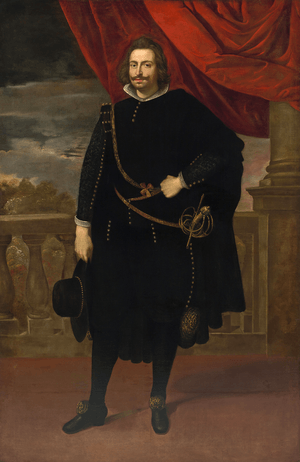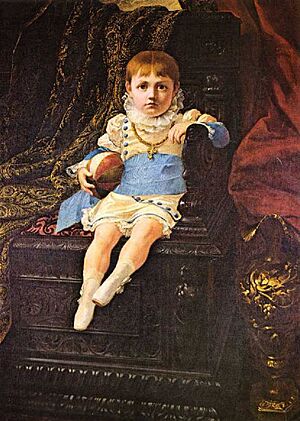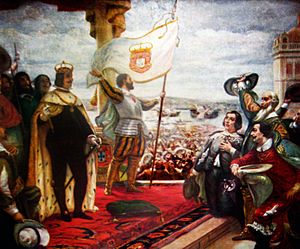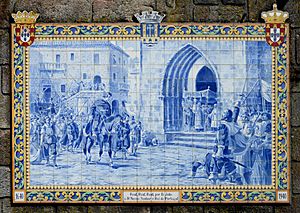John IV of Portugal facts for kids
Quick facts for kids John IV |
|
|---|---|

Portrait by Peter Paul Rubens, around 1628.
|
|
| King of Portugal (more...) | |
| Reign | 1 December 1640 – 6 November 1656 |
| Acclamation | 15 December 1640 |
| Predecessor | Philip III |
| Successor | Afonso VI |
| Duke of Braganza | |
| Tenure | 29 November 1630 – 27 October 1645 |
| Predecessor | Teodósio II |
| Successor | Teodósio, Prince of Brazil |
| Born | 19 March 1604 Ducal Palace of Vila Viçosa, Portugal |
| Died | 6 November 1656 (aged 52) Ribeira Palace, Portugal |
| Burial | Pantheon of the Braganzas |
| Spouse | Luisa de Guzmán (m. 1633) |
| Issue among others... |
Teodósio, Prince of Brazil Joana, Princess of Beira Catherine, Queen of England Afonso VI, King of Portugal Peter II, King of Portugal |
| Dynasty | Braganza |
| Father | Teodósio II, Duke of Braganza |
| Mother | Ana de Velasco y Girón |
| Religion | Roman Catholicism |
| Signature |  |
John IV (born March 19, 1604 – died November 6, 1656) was the King of Portugal. He is often called John the Restorer because he helped Portugal regain its independence from Spain. His rule began in 1640 and lasted until his death.
Before he became king, John was the 8th Duke of Braganza. His grandmother, Catherine, Duchess of Braganza, had also claimed the Portuguese throne years earlier. When John IV died in 1656, the Portuguese Empire was very large, with lands all over the world.
Contents
Early Life
John IV was born in a town called Vila Viçosa. He became the Duke of Braganza in 1630 after his father, Teodósio II, passed away.
In 1633, John married Luisa de Guzmán. She was the oldest daughter of the 8th Duke of Medina Sidonia. People described John as having blonde hair and being of average height.
Becoming King
The Road to Independence
For 60 years, Portugal and Spain had the same king. This was called the Iberian Union. When Philip III became king of Spain and Portugal, things changed. He raised taxes on Portuguese merchants. Portuguese nobles started losing their power and important jobs. Philip III even tried to make Portugal just another Spanish province. This meant Portuguese nobles would lose all their influence.
Because of this, a group of nobles and wealthy citizens planned a revolution. On December 1, 1640, they took action. This was 59 years after Spain's king first took over Portugal. The group, known as the Forty Conspirators, killed the Spanish Secretary of State in Portugal. They also arrested the king's cousin, Margaret of Savoy, who was ruling Portugal for the Spanish king.
Spain was busy fighting other wars at the time, like the Thirty Years' War and a rebellion in Catalonia. This made it hard for Spain to stop the Portuguese uprising.
John IV Takes the Throne
Within hours, and with strong support from the people, John was declared King John IV of Portugal. Legend says his wife, Luisa de Guzmán, helped persuade him to accept the crown. John had a strong claim to the throne through his grandmother, Catherine, Duchess of Braganza.
This event started a long conflict with Spain, known as the Portuguese Restoration War. Portugal also became involved in the wider Thirty Years' War. From 1641 to 1668, Spain tried to isolate Portugal. Portugal, in turn, sought help from other countries and used money from its colonies to stay independent.
The Restoration War
John IV's rule led to a long war with Spain. This war, called the Portuguese Restoration War, finally ended in 1668 when Spain recognized Portugal's independence.
Portugal made alliances with countries like France (in 1641) and Sweden (in 1641). However, Portugal's main fights were against Spain and against the Dutch who were trying to take Portuguese colonies.
Between 1640 and 1668, Portugal and Spain had many small battles. They also had some bigger fights, often because other European powers were involved. Spain was fighting the Thirty Years' War until 1648 and another war with France until 1659. Portugal was fighting the Dutch–Portuguese War until 1663. In Spain, a Portuguese army defeated the Spanish at Montijo in 1644.
Recovering the Empire
While fighting for independence, Portugal also had to protect its empire. The Dutch took Portuguese Malacca in 1641. The Sultan of Oman captured Muscat in 1650.
However, the Portuguese fought back. Even though their forces were spread across Europe, Brazil, and Africa, they managed to win some important victories. They retook Luanda in Portuguese Angola from the Dutch in 1648. By 1654, they had also recovered northern Brazil, which stopped being a Dutch colony. But they did lose Portuguese Ceylon (now Sri Lanka) to the Dutch, who took Colombo in 1656.
Death and Legacy
King John IV died in 1656. His son, Afonso VI, became the next king. John's daughter, Catherine of Braganza, married King Charles II of England.
John IV loved music and art. He was also a talented writer about music and a composer. During his reign, he built one of the largest libraries in the world. Sadly, this library was destroyed in the terrible Lisbon earthquake of 1755.
One famous piece of music, Crux fidelis, is often said to be by him. It is still very popular with church choirs during Holy Week. However, experts believe it was actually written much later, in the 1800s.
In 1646, King John IV made Mary, as the Immaculate Conception, the special Patroness of Portugal. This was a royal order from the House of Braganza.
Titles and Styles
John's title changed as he grew up and became king:
- 19 March 1604 – 29 November 1630: His Lordship Dom John of Braganza
- 29 November 1630 – 1 December 1640: His Excellency The Most Serene Duke of Braganza
- 1 December 1640 – 6 November 1656: His Majesty The King
As King, his full title was: By the Grace of God, John IV, King of Portugal and the Algarves before and beyond the sea in Africa, Lord of Guinea and of Conquest, Navigation, and Commerce of Ethiopia, Arabia, Persia, and India, etc.
Marriages and Descendants
John married Luisa de Guzmán. They had several children together. Some of their children were born and died before John became king. Because of this, they are not officially called infantes or infantas (heirs to the throne) of Portugal.
| Name | Birth | Death | Notes |
|---|---|---|---|
| Children with Luisa de Guzmán (married on January 12, 1633) | |||
| Infante Teodósio | February 8, 1634 | May 13, 1653 | Prince of Brazil and 9th Duke of Braganza. He died young. |
| Ana de Bragança | January 21, 1635 | January 21, 1635 | |
| Infanta Joana | September 18, 1635 | November 17, 1653 | |
| Infanta Catherine | November 25, 1638 | December 31, 1705 | She became Queen of England by marrying Charles II of England. |
| Manuel de Bragança | September 6, 1640 | September 6, 1640 | |
| Infante Afonso | August 21, 1643 | September 12, 1683 | Prince of Brazil and 10th Duke of Braganza. He became King Afonso VI after his father. |
| Infante Peter | April 26, 1648 | December 9, 1706 | He became Duke of Beja and later King Peter II after his brother Afonso. |
| Other Child | |||
| Maria de Bragança | April 30, 1644 | February 7, 1693 | Daughter. |
See also
 In Spanish: Juan IV de Portugal para niños
In Spanish: Juan IV de Portugal para niños




